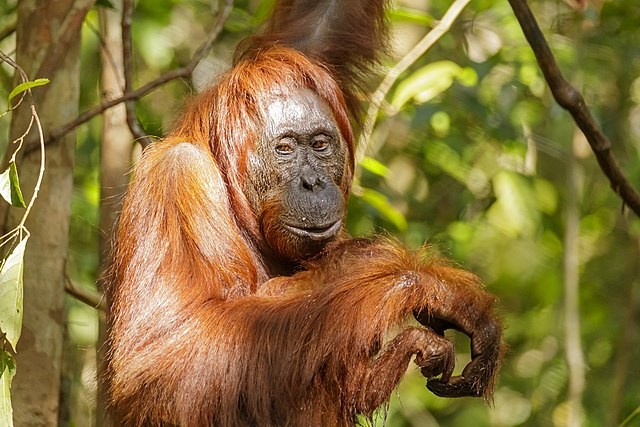
(Photo : Wikimedia Commons/Thomas Fuhrmann)
A Sumatran orangutan impressed many with its self-care knowledge. The primate used a plant to tend its wounds, which healed after over a month.
Orangutan Documented Treating Its Injured Face With Medicinal Plant
At the Suaq Balimbing study site, a protected rainforest area in Indonesia, a male Sumatran orangutan named Rakus suffered a facial wound below his right eye in June 2022. It appears that this injury occurred during a battle with another male orangutan. However, what Rakus did three days later was what scientists couldn't believe and stopped talking about.
In a new study, researchers reported seeing how Rakus seemed to cure the wound with a plant that has antibacterial, anti-inflammatory, antifungal, and antioxidant capabilities that help promote wound healing as well as pain relief.
Primatologist and cognitive biologist Isabelle Laumer of the Max Planck Institute of Animal Behavior in Germany claims that the orangutan chewed the plant's leaves to create a liquid that Rakus repeatedly smeared on the wound and then applied the chewed-up plant material directly to the injury, much like a wound plaster administered by doctors.
According to Laumer, the primary author of the study, Rakus also consumed the plant, an evergreen vine known by the common name Akar Kuning (Fibraurea tinctoria). However, it was kind of surprising because, in this peat swamp forest habitat, where approximately 150 Sumatran orangutans live in critically endangered status, orangutans hardly ever eat the plant.
"To our knowledge, this is the first documented case of active wound treatment with a plant species with medical properties by a wild animal," said study senior author Caroline Schuppli, an evolutionary biologist at the institute.
The orangutan's self-medication did not seem to be accidental, according to the researchers, because he appeared to be acting on purpose.
Rakus only applied the plant juice alone to his right flange face, where he sustained the wound. The action was repeated multiple times, applying plant juice first, and then more substantial plant material until the wound was completely covered. The entire procedure required a significant amount of time.
Laumer acknowledged the chances that the treatment was an "accidental individual innovation." They may have touched their wounds while feeding on the plant. However, it was also possible that Rakus learned the treatment from other orangutans where he grew up.
ALSO READ: Pet Monkey Killed After Ripping a Woman's Ear in Half, Pulling Out Her Hair
Orangutans and Humans
Along with chimpanzees, bonobos, and gorillas, orangutans are among the big apes of the globe and the closest surviving cousins of humans. Despite having the least amount of DNA in common with humans, orangutans are nevertheless quite similar to us. We share approximately 97% of our DNA with them.
The term "orangutan" means "person of the forest" in Indonesian and Malay languages. Orangutans are the largest arboreal mammals in the world. Since they have adapted to live in trees, orangutans lead more solitary lives than other great apes. They swing from branch to branch and sleep and feed in the forest canopy.
They possessed high cognitive capacities, especially in the domain of physical cognition. It is well recognized that they can solve problems quite well. Through observational social learning, wild orangutans develop their skill sets, which are then passed down from generation to generation.
The population where this was observed are known for having a diverse range of cultural practices, including the usage of tools in various settings.
RELATED ARTICLE: Chimpanzee vs Gorilla vs Orangutan Difference: Which Is More Intelligent?
Check out more news and information on Orangutan in Science Times.














